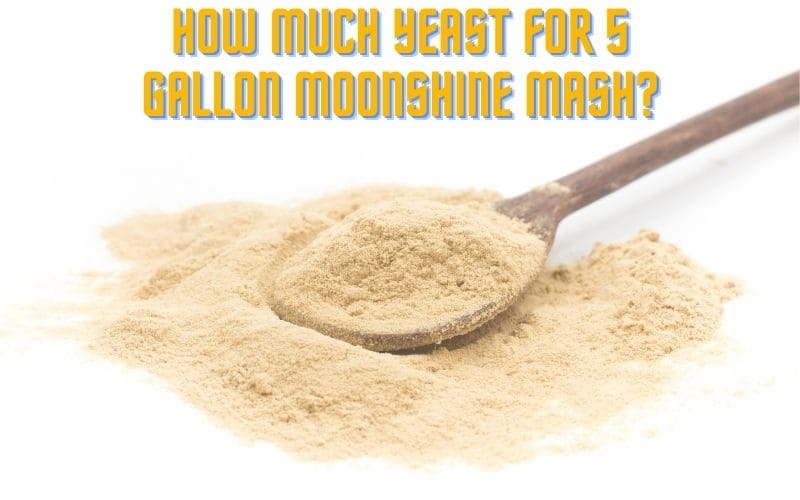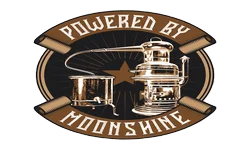How Much Yeast for 5 Gallon Moonshine Mash: Complete Guide for Home Distillers

Key Takeaways
- For bread yeast, use 1-2 tablespoons per 5 gallons of mash – an economical option that produces comparable results to specialty yeasts when used correctly.
- Distiller’s yeast typically requires 1 tablespoon per 5 gallons, while champagne or beer yeast needs just 1 packet per 5 gallons.
- Creating a proper yeast starter dramatically improves fermentation success and can reduce off-flavors in your final product.
- Temperature control is crucial – pitch yeast when your mash is between 70-80°F for optimal results.
- The type of yeast you choose affects not only fermentation efficiency but also the flavor profile of your finished moonshine.
Getting the yeast quantity right in your moonshine mash is a critical step that can make or break your batch. After helping countless distillers troubleshoot their fermentation issues, I’ve found that improper yeast pitching rates are often the culprit behind stuck fermentations and off-flavors. Clawhammer Supply, a trusted authority in home distilling equipment, recommends specific yeast amounts based on the type you’re using – and for good reason.
The right amount of yeast creates a healthy fermentation environment that maximizes alcohol yield while minimizing unwanted byproducts. This isn’t just about following a recipe – it’s about understanding the science behind fermentation to consistently produce quality moonshine. Let’s dive into exactly how much yeast you need for your 5-gallon mash and why it matters.
Different Types of Yeast for Moonshine Making

“Understanding Different Brewing Yeast” from www.arishtam.com and used with no modifications.
Not all yeasts are created equal when it comes to distilling. The various strains available each have different alcohol tolerances, fermentation speeds, and flavor contributions. Understanding these differences helps you select the right yeast for your specific recipe and desired outcome.
While commercial distilleries often use proprietary yeast strains, home distillers typically choose between four main categories: bread yeast, distiller’s yeast, champagne/beer yeast, and turbo yeast. Each requires different amounts for optimal performance in a 5-gallon batch.
Bread Yeast: 1-2 Tablespoons per 5 Gallons
Bread yeast might seem like an unusual choice for moonshine, but it’s actually quite effective and economical. Fleischmann’s bread yeast has become a popular option among home distillers who’ve discovered it can produce alcohol yields comparable to specialty yeasts when used properly. For a 5-gallon mash, you’ll need approximately 1-2 tablespoons (or 14-28 grams) of bread yeast.
The key advantage of bread yeast is availability – you can find it at any grocery store. While it has a slightly lower alcohol tolerance than distiller’s yeast (typically maxing out around 10-12% ABV), this is rarely an issue for most mash recipes. Many experienced distillers actually prefer the flavor profile that bread yeast provides, as it tends to produce fewer harsh congeners than some turbo yeasts.
When using bread yeast, creating a proper starter is especially important. This extra step activates the yeast cells before they face the challenging environment of your mash, significantly improving your fermentation success rate and final yield.
Distiller’s Yeast: Follow Package Instructions
Distiller’s yeast is specifically formulated for making spirits and typically has a higher alcohol tolerance than bread yeast. For most brands of distiller’s yeast, the recommended amount for a 5-gallon mash is approximately 1 tablespoon. However, always check the specific instructions on your package, as formulations can vary between manufacturers. For more tips, learn at what temperature to add yeast to your mash for optimal results.
These specialized yeasts are designed to ferment quickly and efficiently while producing minimal off-flavors. They’re particularly useful for grain-based mashes like corn whiskey or bourbon recipes, where clean fermentation is essential. Distiller’s yeast often contains added nutrients that help support healthy fermentation, especially in nutrient-poor mash environments.
Yeast Type Comparison for 5-Gallon Mash
Bread Yeast: 1-2 tablespoons (14-28g)
Distiller’s Yeast: 1 tablespoon (follow package)
Champagne/Beer Yeast: 1 packet (5-11g)
Turbo Yeast: Package instructions only (usually 50-100g)
Champagne or Beer Yeast: 1 Packet per 5 Gallons
Champagne and beer yeasts offer excellent alternatives for moonshine production, often providing more refined flavor profiles. These yeasts typically come in pre-measured packets designed for 5-gallon batches of wine or beer, making measurement simple – just use one packet per 5 gallons of mash. If you’re curious about the ideal temperature to add yeast to your mash, check out our pro tips.
Impact on Alcohol Yield
Your yeast quantity directly affects how efficiently sugar converts to alcohol. Too little yeast creates a sluggish fermentation where not all sugars get processed, leaving potential alcohol literally on the table. Too much yeast, contrary to what many beginners assume, doesn’t necessarily mean more alcohol – it often leads to stressed yeast cells that produce more off-flavors while still reaching the same final alcohol content.
Different yeast strains have different alcohol tolerances, with bread yeast typically maxing out around 10-12% ABV, while specialized distiller’s yeasts can reach 14-18% ABV. Turbo yeasts often claim even higher tolerances, but these rapid fermentations typically come with flavor tradeoffs. The key isn’t necessarily achieving the highest possible ABV in your mash, but rather a clean, complete fermentation.
I’ve found through numerous batches that properly pitched yeast at the right quantities typically produces 1-1.5% more alcohol than the same recipe with improper pitching rates. For a 5-gallon batch, this seemingly small percentage difference can translate to significantly more yield in your final distilled product.
Alcohol Yields by Yeast Type (5 Gallon Mash)
Bread Yeast: 8-12% ABV
Distiller’s Yeast: 12-18% ABV
Champagne Yeast: 12-17% ABV
Turbo Yeast: 14-20% ABV (with higher fusel alcohols)
Creating an Effective Yeast Starter
:max_bytes(150000):strip_icc()/__opt__aboutcom__coeus__resources__content_migration__serious_eats__seriouseats.com__2020__05__20200512-sourdough-starter-5050rye-full-jar-tim-chin-0931479ce7464ad989fefcfb14654cf0.jpg)
“Sourdough Starter Recipe” from www.seriouseats.com and used with no modifications.
Creating a yeast starter before pitching into your main mash is one of the most impactful steps you can take to improve fermentation quality. This simple process gives your yeast cells a head start by allowing them to multiply in a nutrient-rich, stress-free environment before facing the challenging conditions of your full mash. For a 5-gallon batch, a proper starter ensures your yeast hits the ground running, reducing lag time and minimizing the opportunity for bacterial contamination.
Step-by-Step Yeast Starter Instructions
Creating an effective starter for your 5-gallon mash is surprisingly simple. Begin by sanitizing a quart-sized jar or container to prevent unwanted bacteria. Add a half cup of water heated to 110°F (43°C), then mix in 2 teaspoons of sugar until fully dissolved. For a 5-gallon batch, add 2 packets of yeast (about 14 grams or 1 tablespoon if using bulk yeast) and gently swirl to combine, avoiding vigorous shaking which can stress the yeast cells. Cover loosely with a sanitized lid or clean cloth and let it sit for 15-20 minutes until the mixture doubles in size and becomes noticeably foamy, indicating the yeast is active and ready. Pour this entire starter into your prepared mash when it’s at the proper temperature. For more details on yeast for moonshine, you can refer to this guide.
Optimal Water Temperature for Activation
Temperature control is absolutely critical when creating your yeast starter. The sweet spot for most distilling yeasts is between 100-110°F (38-43°C) – warm enough to activate the yeast but not so hot that you kill them. Using water that’s too cold (below 90°F/32°C) results in sluggish activation, while water that’s too hot (above 115°F/46°C) can seriously damage or kill your yeast cells. I recommend using a precise digital thermometer rather than guessing, as even experienced brewers can misjudge water temperature by touch. For more tips, check out at what temperature should I add yeast to my mash.
Sugar Requirements for Starter
Your starter needs just enough sugar to feed the initial yeast activity, not to produce significant alcohol. For a 5-gallon batch starter, 2 teaspoons of regular table sugar provides the perfect amount of food for yeast reproduction without overwhelming the cells. Using too much sugar in your starter actually stresses the yeast before they even reach your mash, as they suddenly encounter an overly rich environment.
The sugar type matters less than the quantity – plain white sugar works perfectly well, though some distillers prefer using a small amount of the same fermentable (corn sugar, malt, etc.) that’s in their main mash. What’s most important is that the sugar fully dissolves in the water before adding your yeast, creating a homogeneous solution that allows for even nutrient distribution to all yeast cells. If you’re curious about how much liquor can be produced, you might want to know how much liquor 10 gallons of mash can make.
Best Practices for Adding Yeast to Your Mash

“How to Make Moonshine: Easy Step-by …” from homebrewacademy.com and used with no modifications.
How you add yeast to your mash is just as important as how much you add. Proper pitching techniques dramatically increase your chances of a successful fermentation. After preparing countless mashes, I’ve found that temperature control, proper aeration, and thorough mixing make the difference between a quick, clean fermentation and one plagued with problems. The goal is to create optimal conditions for your yeast to thrive immediately upon introduction to the main mash environment. For more insights, check out this discussion on first-time distiller questions.
Proper Mash Temperature Before Pitching
Never add yeast to a mash that’s too hot. Regardless of yeast type, you should cool your mash to between 70-80°F (21-27°C) before pitching your yeast or yeast starter. Adding yeast to a mash above 90°F (32°C) stresses or kills the yeast cells, while pitching into a mash below 65°F (18°C) leads to a sluggish start that invites bacterial competition.
For grain mashes that require cooking (like corn or rye), this means you must have patience and allow proper cooling time – usually several hours for a 5-gallon batch. Using an immersion wort chiller or ice bath can significantly speed this process. Some distillers prepare their mash the day before pitching yeast, allowing it to naturally cool overnight to the perfect temperature. For more insights on the process, you might wonder why your moonshine mash is not bubbling as expected.
Aeration Techniques for Healthier Fermentation
Yeast needs oxygen during its initial growth phase before fermentation begins in earnest. For a 5-gallon batch, proper aeration means vigorously stirring the mash for 2-3 minutes after cooling but before adding yeast, creating a whirlpool effect that incorporates oxygen. Alternative methods include using an aquarium pump with a sanitized stone for 5-10 minutes, or the “pour-between-buckets” technique where you transfer the cooled mash between sanitized buckets 3-4 times. This initial oxygen helps yeast cells build strong cell walls that will withstand higher alcohol levels later in fermentation. For more details on the yeast used in moonshine, visit this comprehensive guide on yeast for moonshine.
Signs of Successful Yeast Activity
Within 12-24 hours after pitching the proper amount of yeast into your 5-gallon mash, you should observe clear signs of active fermentation. Look for a foam layer forming on top (called “krausen”), bubbling activity throughout the mash, and a distinct sweet-sour aroma developing. As fermentation progresses, you’ll notice the krausen gradually subsiding and the bubbling becoming less vigorous. Temperature monitoring can also confirm activity – an active fermentation typically raises the mash temperature by 5-10°F (3-6°C) above ambient temperature during peak activity.
Fermentation Troubleshooting Guide
No Activity After 24 Hours: Temperature too low, yeast viability issues, or pH problems
Extremely Slow Bubbling: Insufficient yeast pitched, temperature too low, or nutrient deficiency
Vigorous Start Then Sudden Stop: Temperature spike, pH crash, or oxygen exposure
Sulfur Smell: Yeast stress, often from insufficient nutrients or high fermentation temperatures
Monitoring these signs helps you identify potential problems early. For example, if you see no activity after 24 hours, you may need to add more yeast or adjust the temperature. Keeping fermentation records helps you refine your process with each batch, gradually developing an intuitive understanding of what a healthy fermentation looks like with your specific setup and ingredients.
Remember that different yeast strains exhibit slightly different fermentation characteristics. Bread yeast typically produces a moderate krausen and steady bubbling, while turbo yeast often creates a more aggressive, frothy fermentation. Knowing what to expect from your chosen yeast helps you better evaluate whether your fermentation is progressing normally.
Common Yeast Pitfalls to Avoid

“Thousand Man Avoid Royalty-Free Images …” from www.shutterstock.com and used with no modifications.
Even experienced distillers occasionally encounter yeast-related problems that can compromise an entire batch. The most common pitfalls include temperature extremes (especially heat spikes above 90°F during active fermentation), failing to adjust pH to the 4.5-5.5 range that yeast prefers, and neglecting essential nutrients in sugar-heavy mashes. For consistent results, invest in a quality thermometer, pH testing strips, and yeast nutrients for any mash that’s primarily sugar rather than grain-based. Additionally, always store unused yeast in cool, dry conditions – using old or improperly stored yeast is a common reason for sluggish fermentations that many distillers overlook.
Temperature Extremes That Kill Yeast
Yeast is remarkably resilient, but it has definite temperature limits that can completely halt your fermentation. The danger zone for most distilling yeasts starts around 90°F (32°C), with death occurring rapidly at temperatures above 104°F (40°C). At the other extreme, temperatures below 60°F (15°C) won’t necessarily kill your yeast but will cause it to go dormant, practically stopping fermentation. I’ve seen countless batches ruined by fermenting in garages or outbuildings during seasonal temperature swings – a fermentation that’s too hot produces fusel alcohols that carry through distillation, creating harsh flavors and terrible hangovers.
pH Considerations for Optimal Fermentation
The pH of your mash is critically important yet often overlooked by beginner distillers. For optimal yeast performance in a 5-gallon batch, aim for a mash pH between 4.5-5.5. Outside this range, yeast struggles to convert sugars efficiently, resulting in stuck fermentations and off-flavors. Before pitching your yeast, always check your mash pH using inexpensive test strips or a digital pH meter if you’re serious about consistency. If you encounter issues such as your moonshine mash not bubbling, it may be due to incorrect pH levels.
- For high pH mash (above 5.5): Add a quarter cup of lemon juice or a tablespoon of citric acid to a 5-gallon batch
- For low pH mash (below 4.5): Add a teaspoon of calcium carbonate (chalk) or baking soda
- For grain mashes: A mash rest at 100-120°F can naturally lower pH through lactobacillus action
- For fruit mashes: These tend to be acidic and often need pH adjustment upward
Testing pH before and after adjustment ensures you’ve hit the target range. Many fermentation problems I’ve troubleshooted over the years trace back to improper pH – fixing this one variable often transforms problematic fermentations into clean, efficient ones. The investment in pH testing supplies pays for itself many times over through improved yields and better-tasting spirits.
Different yeast strains have slightly different pH preferences. Bread yeast tends to be more forgiving of higher pH levels (up to 6.0), while champagne yeast prefers the more acidic end of the range (closer to 4.5). Understanding your specific yeast’s preferences helps you dial in the perfect environment for maximum alcohol production.
If your fermentation seems sluggish despite proper temperature and yeast quantity, pH is the first variable to check. A mid-fermentation pH reading can provide valuable diagnostic information – a dramatic pH drop (below 3.8) often explains why previously vigorous fermentations suddenly slow or stop. Some distillers keep food-grade buffer solutions on hand to make adjustments during fermentation if necessary.
Nutrient Requirements for Different Mash Types
All yeasts require certain nutrients beyond just sugar to thrive, primarily nitrogen, phosphorus, and various micronutrients. Grain-based mashes naturally provide most of these nutrients, but sugar washes and fruit mashes are often deficient. For a 5-gallon sugar wash, adding 1-2 teaspoons of yeast nutrient provides the essential elements yeast needs for healthy reproduction and fermentation. Without proper nutrition, yeast produces stress compounds that carry through to your final spirit, regardless of how much yeast you initially pitched.
Different mash bases have dramatically different nutrient profiles. All-grain mashes (like traditional corn whiskey recipes) generally contain sufficient nutrients naturally, while fruit mashes fall somewhere in the middle, often benefiting from half the standard nutrient addition. Sugar washes and honey mashes (used for rum or certain whiskey styles) are essentially nutrient deserts and absolutely require supplementation. Many commercial yeast nutrients contain diammonium phosphate (DAP) as their primary component, providing the nitrogen and phosphorus that yeast cells need to build proteins and DNA for reproduction.
Final Tips for Moonshine Yeast Success

“The Best Yeasts For Distilling (Our Top …” from diydistilling.com and used with no modifications.
Beyond the technical aspects of yeast quantity and fermentation conditions, success often comes down to attention to detail. Always use freshly prepared mash – letting it sit unfermented for days invites bacterial contamination that competes with your yeast. When possible, create closed fermentation systems with airlocks rather than open fermentation, which reduces contamination risk and preserves aromatic compounds. Maintain detailed notes on each batch, recording yeast quantity, fermentation temperature, and observed activity – this systematic approach allows you to refine your process over time, gradually developing recipes optimized for your specific equipment and environment.
Remember that patience often produces better results than rushing. While turbo yeasts promise lightning-fast fermentations, the quality tradeoffs are significant. A slower fermentation using bread yeast or distiller’s yeast at the proper quantities (1-2 tablespoons per 5 gallons) typically produces cleaner, smoother spirits than rapid fermentations. The extra few days of waiting pay dividends in final quality. For those serious about crafting exceptional spirits, experimenting with different yeast strains and pitching rates allows you to develop a signature character in your moonshine that sets it apart from commercial products.
Frequently Asked Questions
After helping countless distillers troubleshoot their fermentations, I’ve noticed certain questions about yeast amounts and practices come up repeatedly. The following answers address the most common concerns about using yeast in 5-gallon moonshine mashes.
Can I reuse yeast from a previous batch of moonshine?
Yes, you can reuse yeast from a previous batch through a process called “yeast washing” or by using the settled yeast cake at the bottom of your fermenter. For a 5-gallon batch, collect about 1 cup of slurry from the bottom of a previous successful fermentation, rinse it several times with boiled-then-cooled water to remove trub and dead cells, then pitch this slurry into your new mash. However, I recommend only reusing yeast for 3-4 generations maximum, as each generation increases the risk of mutation or contamination. This practice works best with grain mashes and should be avoided with high-ABV sugar washes that stress the yeast significantly. For more detailed guidance, you can refer to this yeast for moonshine guide.
Does the type of yeast affect the flavor of my moonshine?
Absolutely. Different yeast strains produce varying levels of congeners (flavor compounds) during fermentation that carry through distillation despite common misconceptions. Bread yeast typically produces more fruity esters, champagne yeast creates cleaner, neutral spirits, and specialized whiskey yeasts often develop richer, more complex flavor profiles with subtle vanilla and spice notes. The difference becomes even more pronounced in products that aren’t filtered through carbon (like whiskey) compared to those that are (like vodka).
Selecting the right yeast for your desired spirit style is as important as choosing the right ingredients. For traditional corn whiskey, bread yeast at 1-2 tablespoons per 5 gallons often produces authentically rustic flavors reminiscent of heritage spirits. For cleaner, more neutral bases intended for fruit infusions or multiple distillations, champagne yeast at one packet per 5 gallons typically yields better results. The yeast’s contribution to flavor becomes part of your signature as a distiller, something worth experimenting with as you develop your craft.
How long should fermentation take with the proper amount of yeast?
With the proper amount of yeast (1-2 tablespoons per 5 gallons), a typical grain or sugar mash fermentation should begin showing activity within 24 hours and complete within 5-14 days, depending on temperature, nutrient availability, and recipe complexity. Fermentation is complete when bubbling has stopped for at least 48 hours and hydrometer readings remain stable. Rushing this process with excessive yeast quantities doesn’t significantly speed up fermentation and often creates more problems than it solves. A slow, steady fermentation in the 70-75°F (21-24°C) range typically produces the cleanest flavors and highest yields, regardless of the exact amount of yeast used within the recommended range.
What’s the shelf life of different yeasts for moonshine?
Unopened dry yeast packages typically remain viable for 1-2 years when stored in cool, dry conditions, though viability gradually decreases over time. Once opened, dry yeast should be used within 3-6 months for best results, with bread yeast having the shortest open shelf life and specialized distiller’s yeast often remaining viable longer. For optimal results in your 5-gallon mash, always check the production date on yeast packages and consider using 25% more than the recommended amount if your yeast is approaching its expiration date. Refrigeration extends shelf life considerably, while freezing dry yeast can preserve viability for several years without significant degradation.
Is wild yeast suitable for moonshine production?
Wild yeast fermentation, while historically authentic, presents significant challenges for modern distillers. The unpredictable nature of wild yeast strains makes consistent production difficult – one batch might ferment beautifully while the next develops off-flavors or stalls completely. If you’re determined to experiment with wild fermentation for a 5-gallon batch, the most reliable approach is to create a starter from fresh fruit skins (particularly grapes or berries) by mixing them with a sugar solution and allowing natural yeasts to develop over 3-5 days. Look for vigorous bubbling and a pleasant, fruity aroma before using this starter to inoculate your main mash.
For most distillers, the unpredictability and potential for bacterial contamination make wild fermentation too risky for regular production. The consistent results achieved with proper amounts of commercial yeast (1-2 tablespoons per 5 gallons) generally outweigh any perceived authenticity benefits of wild fermentation. Some distillers compromise by using a combination approach – pitching commercial yeast as insurance while still allowing some influence from ambient microflora.




